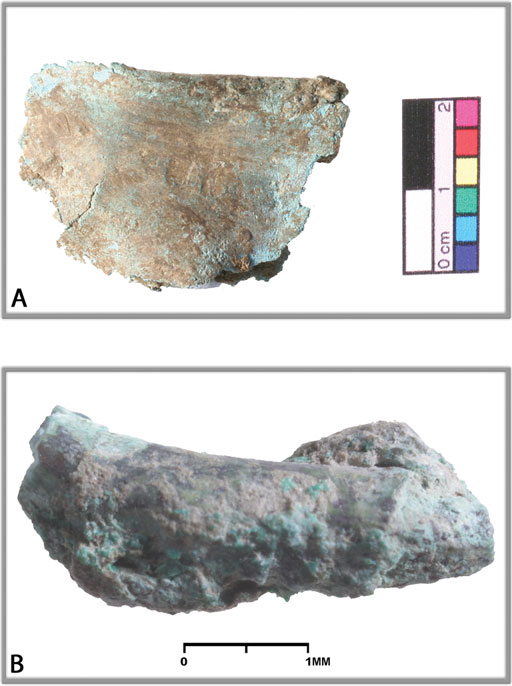黄铜是由铜和锌所组成的合金。铜锌合金=黄铜
目前世界上最早的冶炼铜发现于中国的陕西。
1973年,在陕西临潼姜寨文化遗址中,发现了一块半圆形黄铜片和一块黄铜管状物,
年代测定为公元前4700年左右。
1972年在河北藁城台西村商代(公元前14世纪)遗址中出土了一件铁刃铜钺。全钺残长11.1厘米,阑宽 8.5厘米,外刃部断失,残存刃部包入铜内约 1厘米,已全部氧化。经鉴定,残刃中没有人工冶铁的特征;镍的分布表明,该刃为陨铁制成,不可能用人工冶铁获得。

陨铁的主要成分是铁、镍,其镍含量一般在4 ~20%之间。迄今为止,中国出土了 4件陨铁刃青铜兵器。除上述外,还有北京平谷县刘家河商墓出土的陨铁刃铜钺1件,残长8.4厘米,呈长方形,有上下阑,铁刃嵌入钺身内约 1厘米,已全锈蚀。另两件是1931年河南浚县出土的商末周初的铁刃铜钺和铁援铜戈。前者长17.1厘米,宽10.8厘米,重437.5克;后者长18.3厘米,宽7厘米,重378.5克,现存美国华盛顿弗里尔美术馆。
陨铁器虽然不是从矿石冶炼的铁,但它的出现表明中国在公元前14世纪前后已能识别金属铁,并能锻打成兵刃使用。
--------------

意大利米兰理工大学材料学教授达妮埃拉· 科梅利(Daniela Comelli)领衔的研究团队对匕首的刀片部分进行了分析,显示其中包含10%的镍和0.6%的钴,研究报告发表在《陨石学与行星科学》杂志上。
考古学家霍华德· 卡特(Howard Carter)在发现埃及法老墓3年之后,于1925年发现了这把匕首。???
研究人员称,匕首被缠绕在法老木乃伊的右腿侧,手柄用黄金装饰,圆头则以水晶打造,铁刀片有黄金剑鞘保护,剑鞘上一边刻着百合花图案,另一边刻着羽毛和一只豺的头。
科梅利称,匕首的历史要追溯到公元前14世纪,在当时的古埃及文化中,铁器是十分稀少的,据考证埃及到公元前8世纪才发明炼铁技术,比周围的国家要晚。“由于铁的熔点太高(1538 ℃),早期的锻工无法加热到这么高的温度来提取铁,更遑论将其制成武器了。”科梅利说。
研究人员在论文中写道:“在这种背景下,法老匕首刀片制作工艺之精良证明在公元前14世纪存在成熟的铁锻造技术。”这个发现也能很好地说明大约100年后,埃及使用了“天空的铁(iron of the sky)”来描述铁。
“这个新术语的引入表明,古埃及人在公元前13世纪就已经知道,这些铁块是从天上掉下来的。”研究人员表示。
-------------
The age of bronze:
from 2800 BC. Sometimes the ores of copper and tin are found together, 共生矿 and the casting of metal from such natural alloys may have provided the accident for the next step forward in metallurgy.
It is discovered that these two metals, cast as one substance, are harder than either metal on its own. The cast alloy of copper and tin is bronze, a substance so useful to human beings that an entire period of early civilization has become known as the Bronze Age.
Copper is the eighth most abundant metal in the Earth’s crust, available all over the world and one of the few that can appear in pure state.
Copper-zinc alloys were produced as early the 5th millenia BC in China and were widely used in east and central Asia by the 2nd and 3rd century BC. These artifacts, however, may be best referred to as 'natural alloys', as there is no evidence that their producers consciously alloyed copper and zinc. Instead, it is likely that the alloys were smelted from zinc-rich copper ores, producing crude brass-like metals.
Greek and Roman documents suggest that the intentional production of alloys similar to modern brass, using copper and a zinc oxide rich ore known as calamine, began around the 1st century BC.
http://metals.about.com/od/properties/a/The-History-Of-Brass.htm
------------
The hypothesis of a single origin for Eurasian metallurgy has been challenged by the discovery of copper smelting evidence some 7000 years old at Plochnik, a Vincha culture settlement in eastern Serbia. Here, the tin-bronze foil was excavated from an undisturbed context, on the floor of a dwelling structure next to a copper workshop – a single occupation horizon dated to circa 4650 BCE. The tin-bronze foil from the site of Plochnik is therefore the earliest known tin-bronze artefact anywhere, extending the record of bronze making by about 1500 years.
http://haemus.org.mk/6500-year-old-tin-bronze-from-serbia/?
下图为 这个出土与 塞尔维亚的 铜片/铜箔 长约3.7cm, 宽约2.5cm
据说 距今 6600多年

---------------
January 08, 2014
6,500-year old tin bronze from Serbia
Tainted ores and the rise of tin bronzes in Eurasia, c. 6500 years ago
Miljana Radivojevi? et al.
The earliest tin bronze artefacts in Eurasia are generally believed to have appeared in the Near East in the early third millennium BC. Here we present tin bronze artefacts that occur far from the Near East, and in a significantly earlier period. Excavations at Plo?nik, a Vin?a culture site in Serbia, recovered a piece of tin bronze foil from an occupation layer dated to the mid fifth millennium BC. The discovery prompted a reassessment of 14 insufficiently contextualised early tin bronze artefacts from the Balkans. They too were found to derive from the smelting of copper-tin ores. These tin bronzes extend the record of bronze making by c. 1500 years, and challenge the conventional narrative of Eurasian metallurgical development.
Link
January 19, 2014
http://forwhattheywereweare.blogspot.com/2014/01/first-ever-bronze-was-smelt-in-balcans.html
【】
First ever bronze was smelt in the Balcans. 巴尔干 It seems that West Asia 西亚 is losing a bit of its relevance as the origin of nearly every development. Much as the first steel is now known to have been made in Central Africa several centuries before the Hittites (or not: see update below), the first bronze ("tin bronze" to be specific) seems now to have been made in the Balcanic peninsula, more than a thousand years before it was in Mesopotamia. 美素不达米亚。
Miljana Radivojevi?c et al. Tainted ores and the rise of tin bronzes in Eurasia, c. 6500 years ago. Antiquity 87 (2013).
Abstract
The earliest tin bronze artefacts in Eurasia are generally believed to have appeared in the Near East in the early third millennium BC. Here we present tin bronze artefacts that occur far from the Near East, and in a significantly earlier period. Excavations at Plocnik, a Vinca culture site in Serbia, 塞尔维亚 recovered a piece of tin bronze foil from an occupation layer dated to the mid fifth millennium BC. The discovery prompted a reassessment of 14 insufficiently contextualised early tin bronze artefacts from the Balkans. They too were found to derive from the smelting of copper-tin ores. 红铜-锡矿 These tin bronzes extend the record of bronze making by c. 1500 years, and challenge the conventional narrative of Eurasian metallurgical development.
The specific well-dated finding is from Plocnik, Southern Serbia, however as we can see in the map below, most 5th millenium bronze sites are from Bulgaria 保加利亚.